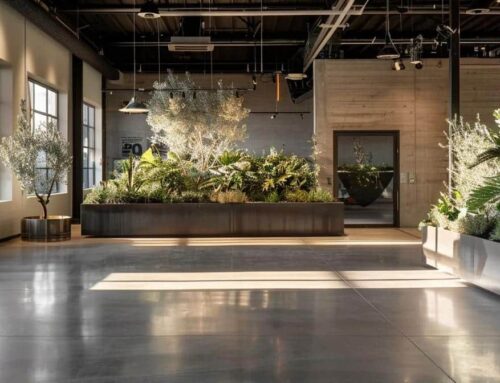Are you looking to enhance your garden while minimizing your environmental impact? Eco-friendly hardscape materials can provide the perfect solution. This article will guide you through selecting natural stone, exploring recycled options, and utilizing permeable pavers. By understanding these sustainable choices, you’ll not only create a beautiful outdoor space but also contribute to better water management and reduced waste. Discover how incorporating eco-friendly materials can transform your garden while addressing common sustainability concerns.
Understanding Eco-Friendly Hardscape Solutions

Eco-friendly hardscaping involves using sustainable materials and practices to create beautiful outdoor living spaces. Companies such as bret-mar landscape exemplify this approach. I believe it’s essential to prioritize sustainability in garden design, as it significantly impacts our environment. Additionally, there are common misconceptions about eco-friendly materials, such as flagstone and recycled options for features like ponds and fences. If you’re searching for a hardscape landscape near me, in the following sections, I’ll clarify these key topics, providing insights into how you can effectively integrate eco-friendly solutions into your landscaping projects.
Defining Eco-Friendly Hardscaping
Eco-friendly hardscaping focuses on the use of sustainable materials and techniques to enhance outdoor spaces while conserving natural resources. As a professional in this field, I’ve seen firsthand how homeowners can minimize environmental impact through choices like permeable surfaces that support water resources and reduce runoff. Utilizing low-impact materials, such as recycled cement alternatives, not only promotes energy conservation but also significantly reduces the need for harmful herbicides in landscaping, creating a healthier environment for both gardens and their caretakers.
Importance of Sustainability in Garden Design
Integrating sustainable practices in garden design is vital for ensuring environmental protection while creating beautiful outdoor spaces. As I emphasize to my clients, using materials that support zero waste initiatives, such as sod grown on recycled substrates, contributes to the longevity of the landscape. Incorporating features like bioswales not only manages stormwater effectively but also enhances the natural aesthetics of the garden, creating a harmonious balance between functionality and eco-friendliness.
Common Misconceptions About Eco-Friendly Materials
Many homeowners assume that eco-friendly materials lack durability or aesthetic appeal, which is simply not true. For instance, decomposed granite is not only sustainable but also provides a beautiful, natural look while helping to improve water quality by allowing better drainage and reducing runoff. Additionally, using recycled materials in hardscaping can lower carbon emissions and pollution, proving that sustainable choices can serve as effective infrastructure solutions for any garden.
When you seek beauty in a garden, the choice of stone matters. Selecting the right natural stone will not only enhance your space but also respect the earth beneath it.
Selecting Natural Stone for Sustainable Gardens

Natural stone offers numerous benefits over other materials, making it an ideal choice for sustainable gardens. I emphasize the importance of sourcing locally to minimize environmental impact while incorporating elements like lantana and woodchips to enhance beauty and function. Additionally, I will discuss best practices for maintenance that ensure the longevity of natural stone features, all while embracing a minimalist design aesthetic.
Benefits of Natural Stone Over Other Materials
Natural stone, particularly limestone, stands out as a sustainable choice for gardens due to its durability and low environmental footprint. Unlike synthetic materials, limestone helps maintain proper groundwater levels, which is crucial in times of drought. Furthermore, using natural stone reduces the reliance on air conditioning by retaining cooler surface temperatures, making your outdoor space more comfortable and energy-efficient for homeowners.
Sourcing Locally to Reduce Environmental Impact
Sourcing natural stone locally is a key strategy I recommend for reducing environmental impact in sustainable landscape design. By selecting materials that are harvested nearby, we can significantly cut down on transportation emissions and avoid contributing to construction waste. This approach not only supports the local economy but also provides an opportunity to incorporate regional features into your lawn, enhancing its overall aesthetic and ecological value.
Maintenance Practices for Longevity
To prolong the life of natural stone in sustainable landscapes, regular maintenance is essential. I recommend periodically removing organic matter, such as leaves and debris, which can trap moisture and promote the growth of unwanted pests. Additionally, when necessary, applying eco-friendly wood mulch can help suppress weeds and minimize the need for pesticides, creating a healthier environment for plants while preserving the integrity of the stone features in your garden.
Natural stone brings life to gardens, but the search for sustainable options doesn’t end there. Let’s turn our attention to the creative possibilities of recycled and upcycled hardscapes that can give your outdoor space a unique edge.
Exploring Recycled and Upcycled Hardscape Options

Incorporating recycled materials into hardscaping offers practical solutions for landscape design. Popular options like reclaimed brick or crushed concrete not only enhance permeability and soil health but also reduce dust and environmental impact. I’ll explore creative upcycling ideas and the environmental advantages of using these materials, highlighting how they contribute to a sustainable, aesthetically pleasing garden.
Popular Materials Made From Recycled Components
In my experience with sustainable landscaping, utilizing recycled materials can significantly enhance garden design while promoting environmental responsibility. Popular options include reclaimed brick and crushed concrete, which not only offer aesthetic appeal but also facilitate infiltration, helping with water management in your outdoor spaces. Additionally, using recycled granite for pathways or garden furniture allows homeowners to create stylish, durable features that align with their eco-friendly values.
- Reclaimed brick for attractive pathways
- Crushed concrete for permeable surfaces
- Recycled granite for durable garden furniture
Creative Uses of Upcycling in Garden Design
In my experience, upcycling can be a transformative approach in garden design, offering practical benefits that align with eco-friendly goals. For example, repurposing old wooden pallets into vertical planters not only enhances drainage but also supports water conservation by reducing runoff. This not only minimizes greenhouse gas emissions associated with manufacturing new materials but also creates a habitat for various plant species, enriching the biodiversity of your garden.
Environmental Benefits of Choosing Recycled Materials
Choosing recycled materials for your garden construction not only adds beauty but also brings significant environmental advantages. For instance, using pervious concrete allows stormwater to permeate, reducing runoff and helping maintain the local ecosystem. In my experience, incorporating reclaimed elements during renovation not only minimizes waste but also naturally reduces pest issues, creating a healthier environment for your plants and outdoor spaces.
Recycled materials shape hardscapes, but there’s more to consider. Permeable pavers offer a smart way to manage rainwater, allowing nature to do its work.
Utilizing Permeable Pavers for Sustainable Drainage

Permeable pavers are an excellent choice for creating sustainable landscapes, allowing water to flow through and reduce runoff. I will discuss how these pavers work, their advantages in enhancing the natural environment, and effective installation techniques to ensure optimal results. This approach not only supports perennial gardens but also contributes to effective drainage in your outdoor spaces.
How Permeable Pavers Work
Permeable pavers are designed to allow water to flow through their surface, promoting effective drainage and supporting soil moisture levels in the surrounding area. As a landscape architect, I prioritize these environmentally friendly solutions for their durability and ability to reduce runoff, ultimately benefiting local ecosystems. A proper soil test can determine the best installation practices for permeable pavers, ensuring they integrate seamlessly into your garden while enhancing its overall health and sustainability.
Advantages of Permeability in Garden Spaces
Utilizing permeable pavers in garden spaces significantly combats urban heat island effects by allowing sunlight to penetrate and heat to dissipate through the soil. This approach helps maintain cooler temperatures while supporting healthier soil moisture levels, which benefits plant growth and enhances biodiversity. For example, integrating materials like bluestone in a permeable pattern not only adds aesthetic value but also improves drainage, enabling excess rainwater to flow through and replenish groundwater supplies.
- Reduces urban heat island effects
- Supports soil moisture retention
- Enhances aesthetic appeal with materials like bluestone
- Improves drainage for healthier plant life
Installation Techniques for Best Results
For the best results with permeable paving, it’s essential to start with proper site preparation, ensuring the ground is level and well-compacted. I recommend incorporating a rain garden to help manage stormwater effectively and improve drainage. Selecting high-quality materials and utilizing correct installation methods can enhance the performance of green infrastructure while supporting horticulture in your outdoor spaces:
- Prepare the site with a stable base
- Incorporate a rain garden for stormwater management
- Choose high-quality permeable materials
- Follow best practices for proper installation
As we consider how permeable pavers enhance drainage, let’s turn our attention to organic mulches and wood products. These materials not only beautify but also serve practical purposes, enriching the landscape further.
Integrating Organic Mulches and Wood Products

Using organic mulches and wood products in garden design offers numerous advantages, from enhancing soil health to reducing carbon footprints. I will discuss the benefits of using wood chips as ground cover and the importance of sourcing sustainable wood products. Additionally, I will compare different types of organic mulches, helping you select the best building material for your patio while prioritizing sustainability.
Benefits of Using Wood Chips as Ground Cover
Using wood chips as ground cover in your garden can significantly improve soil health while also reducing the risk of disease among your plants. In my experience, wood chips retain moisture, promote beneficial microorganisms, and suppress weed growth, which are essential for any healthy crop. This organic material not only enriches the soil but also supports sustainable agriculture practices, making it an excellent choice for environmentally-conscious construction projects that seek to enhance the overall effectiveness of your landscape while prioritizing ecological welfare.
Sourcing Sustainable Wood Products
Sourcing sustainable wood products is essential for enhancing the ecosystem and promoting biodiversity in your garden. I prioritize using materials from well-managed forests, ensuring that every piece of wood, whether for a fire pit or garden structure, aligns with conservation efforts. Utilizing wood from local sources not only reduces transportation emissions but also supports local economies, creating a positive impact on your community and its natural surroundings.
- Focus on using wood from well-managed forests to support sustainability.
- Prioritize local sourcing to minimize transportation emissions.
- Utilize wood in various features, such as fire pits, to enhance outdoor aesthetics.
- Consider the environmental impact on ecosystems and biodiversity.
Comparing Different Types of Organic Mulches
When comparing different types of organic mulches, it’s essential to consider their effectiveness in environmental sustainability and how they can support practices like xeriscaping. For instance, wood chips provide excellent moisture retention, minimizing the impact of wind and reducing the need for watering, which subsequently lowers greenhouse gas emissions associated with water usage. Each mulch type, such as straw or shredded leaves, can also play a role in preventing environmental degradation by enhancing soil quality and promoting healthy growth for landscaping features, including pavers.
- Wood chips for moisture retention
- Straw for weed suppression
- Shredded leaves for nutrient enrichment
- Xeriscaping benefits for water conservation
Organic mulches enrich the earth, but there is more to a beautiful outdoor space. Now, let’s explore innovative eco-friendly hardscape designs that elevate aesthetics and sustainability.
Conclusion
Utilizing eco-friendly hardscape materials in your garden not only enhances aesthetic appeal but also plays a pivotal role in promoting environmental sustainability. By choosing options like natural stone, recycled components, and permeable surfaces, you can create beautiful outdoor spaces that support local ecosystems and reduce waste. Incorporating these materials helps maintain soil health, manage water resources, and foster biodiversity in your landscape. Embrace eco-friendly solutions to ensure your garden thrives while making a positive impact on the environment.




